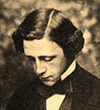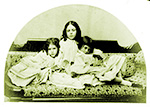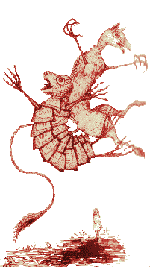... OXFORD ...

Charles Dodgson aged about 25
He left Rugby at the end of 1849 and, after an interval which remains unexplained, went on in January 1851 to Oxford: to his father's old college, Christ Church. He had only been at Oxford two days when he received a summons home. His sweet and beloved mother had died of "Inflammation of the Brain" -- perhaps meningitis or a stroke -- at the age of forty-seven. Whatever Dodgson's feelings may have been about this death, he recorded nothing of them for posterity, and indeed there is no record of his ever mentioning his mother either in the private diary he began keeping two years after her death, or in any surviving letters. The reasons for this curious silence can only be guessed at. After Frances Jane's death, her sister Lucy moved in with the family to take care of the children. She remained a much-loved member of the household until her death in 1880, and Dodgson's diaries and letters are full of quietly affectionate references to 'Aunt L'.
At Oxford Charles Dodgson the undergraduate may not always have worked hard, but he was exceptionally gifted and achievment came easily to him. In December 1852 he achieved a first in Honour Moderations, and shortly after he was nominated to a Studentship (the Christ Church equivalent of a fellowship), by his father's old friend Canon Edward Pusey. He was to remain a Student at Christ Church for the rest of his life.

The young adult Charles Dodgson was about six foot tall, slender and fairly handsome, with curling brown hair and blue eyes. At the unusually late age of seventeen he suffered a severe attack of whooping cough which left him with poor hearing in his right ear and was probably responsible for his chronically weak chest in later life. he also suffered what he referred to as his "hesitation" -- a stammer he had acquired in early childhood and which was to plague him throughout his entire life. It is often claimed he only stammered in adult company, and was free and fluent with children, but there is nothing to support this idea. Many children of his acquaintance remembered the stammer; many adults failed to notice it. But, although his stammer troubled him it was never bad enough to stop him using his other qualities to do well in society.
Although he has often been described as shy, he does not in reality semm to have been so. In fact he seems to have been quite gregarious and was always quite socially active. He could sing quite well and was not afraid to do so in front of an audience. He was adept at mimicry and, of course, story-telling. His diaries give little away about his spiritual and emotional life, but there are a few hints at a sense of the spiritual and the divine. 'That is a wild and beautiful bit of poetry, the song of "call the cattle home",' he suddenly observed, in the midst of an analysis of Kingsley's novel Alton Locke :
I remember hearing it sung at Albrighton: I wonder if any one there could have entered into the spirit of Alton Locke. I think not. I think the character of most that I meet is merely refined animal... How few seem to care for the only subjects of real interest in life.
This moment of unusual frankness gives us a rare glimpse of young Dodgson's inner mind. Alas he says nothing more of what he considered the 'only subjects of real interest' to be.
Although often described in biographies as hardworking, in reality his early academic career was very uneven. Through his own self-confessed laziness he failed an important scholarship, but despite this his brilliance as a mathematician won him the Christ Church Mathematical Lectureship, which he continued to hold for the next 26 years. It was a job he never enjoyed very much.
From earliest adolescence, if not before, he was writing; poetry, short stories, for his family magazines, and by the mid 1850s he was sending his work to various magazines, already enjoying moderate success. Between '54 and '56, his work appeared in the national publications, The Comic Times and The Train, as well as smaller magazines like the Whitby Gazette and the Oxford Critic. Most of his output was comic, sometimes sharply satirical. But he set himself high standards. "I do not think I have yet written anything worthy of real publication (in which I do not include the Whitby Gazette or the Oxonian Advertiser), but I do not despair of doing so some day," he wrote in July 1855.
In addition to his writing pursuits, he had no shortage of other interests. He loved the theatre and the arts in general and the happiest times of his young life were spent away from Oxford enjoying the artistic pleasures of London. Then, in 1856 he took up the new art form of photography, which was to be a passion of his for the next 24 years. He was one of the best amateur photographers of his time, and made studies of numerous famous men and women, as well - famously and infamously - as many children. His interest in making nude studies of children has been widely interpereted as an indication he was pedophilic, but in recent times this has been called into serious question.
According to his biographer and nephew Stuart Collingwood, young Charles began to keep a diary almost as soon as he could write, and he apparently kept it regularly, as Collingwood says there was only one notable gap - for the three years that Dodgson as at Rugby School. Strangely, all record of these very early diaries seems to have vanished. However in about 1853 Dodgson began a new series of numbered diary volumes which he continued to keep until his death, and most of these do survive, although even here the record is not complete.
Some time after his death, some members of his family deliberately cut out and destroyed certain pages, while four of the 13 volumes, including two consecutive ones covering the years 1858-62 went missing and have never been recovered. The fate of these volumes, and the possible reasons behind the destruction, are some of the major mysteries and anomalies that surround Lewis Carroll's real life. Most of this missing material dates from a single decade (between 1853 and 1863), and is so extensive that it amounts to five and a half years of missing time. Over half the record for a single ten-year period of Dodgson's life is completely missing and we currently have no firm idea of why. The loss of this material means that there is very little information about what he was doing or thinking during this very important and formative time. The story is fragmentary and there is more unknown than there is known. It's essential that anyone writing about his life takes note of this, especially as the period the lacuna covers is one that was possibly very significant for him, for the reasons shown below.
One very noticeable thing about the four-year gap in Carroll's diaries between 1858 and 1862, is the way his diary 'voice' changes during the gap. In the final volume before the break his entries are normal and quite care-free, but in the first volume after the break things have noticeably changed, and for the very first time he begins writing very intense prayers to God to forgive him for some undisclosed sin. At around the same time he also began writing various love poems, some of which describe being seduced and sleeping with a beautiful woman. It's not known if the confessions of sin and the love poetry are connected, though his first biographer, Stuart Collingwood, hinted the poetry was based on some real and unhappy experience.
During this turbulent period he rejected the priesthood that had been his planned career since childhood. This step should have cost him his Studentship and his job as Mathematical Lecturer, but Dean Liddell, somewhat inexplicably, decided to effectively break college rules in order to allow Dodgson to remain at Christ Church without taking holy orders. Nothing about this curious episode has yet been satisfactorily explained.

Ina, Alice and Edith Liddell, photographed by Dodgson,
In 1856 he published his first piece of work under the name that would make him famous. A very predictable little romantic poem called "Solitude" appeared in The Train under the authorship of 'Lewis Carroll'.
In the same year, Christ Church acquired a new Dean
(head of college),
when Thomas Gaisford died and was replaced by one Henry George
Liddell, who brought with him a young wife and children,
all of whom
would figure largely in Dodgson's life over the following
years. Dodgson
quite quickly became close friends with the mother and
the children. They were a beautiful family. The mother, Lorina, was a
"beauty of the Spanish type", and her children had inherited her
dark comeliness which was exactly the kind Dodgson liked to
photograph. He made many studies of the family, especially his three favourites
the sisters Ina, Alice and Edith. Although the diaries covering the period
of the developing
friendship are now missing,
it appears that his friendship with the family blossomed, and there
became something of a tradition of his taking the children
out on the river
for picnics at Godstow or Nuneham.

It was on one such expedition, in 1862, that Dodgson invented the outline of the story that eventually became his first and largest commercial success -- the first Alice book. Having told the story and been begged by Alice Liddell to write it down, Dodgson was evidently struck by its potential to sell well. After consulting various friends, including the author George MacDonald, he took the MS to Macmillan the publisher who liked it immediately. Bravely, or crazily, Dodgson undertook to pay for the cost of publication himself in return for 90% of the royalties. Even though his income was well above the national average at £500 per annum, this was still a considerable risk. In the end, though, the gamble was to pay off, and by the end of his life the two 'Alice' books had grossed him approximately £50,000.
Alice's Adventures in Wonderland was published in 1865, under the pen-name Dodgson had first used some nine years earlier -- Lewis Carroll.
Biography compiled by the webmaster © carrollmyth.com/lewiscarroll.cc
NB:You are welcome to use this material under the stipulations of 'FAIR USE', but please cite the source.